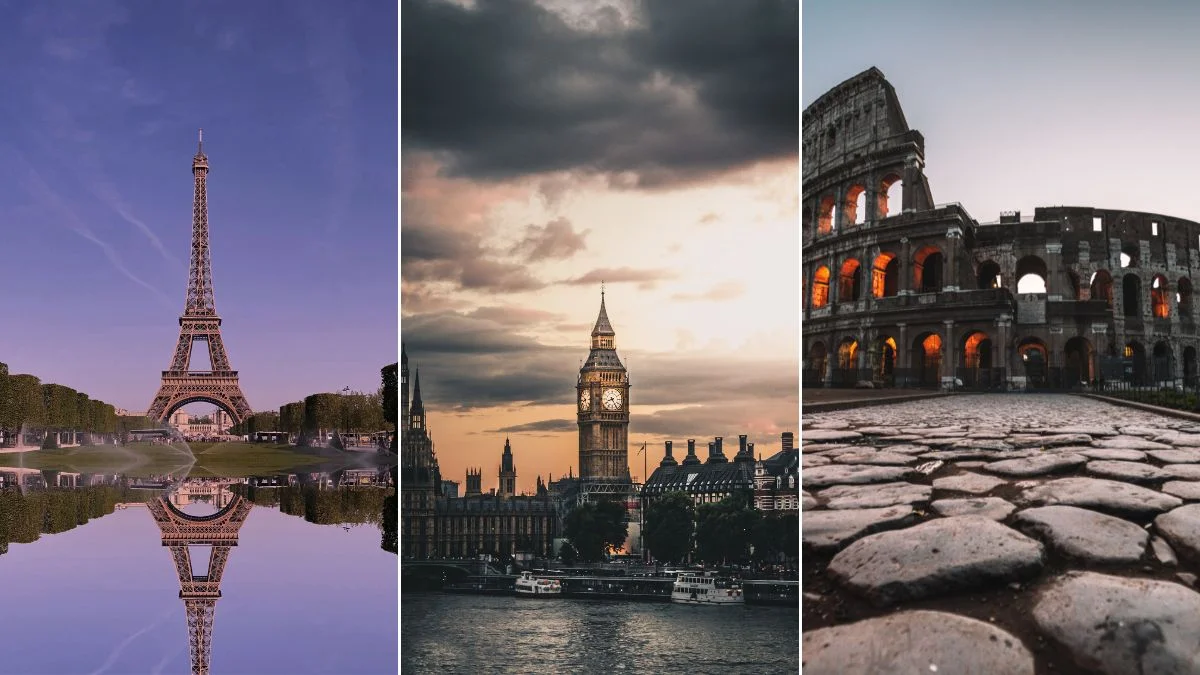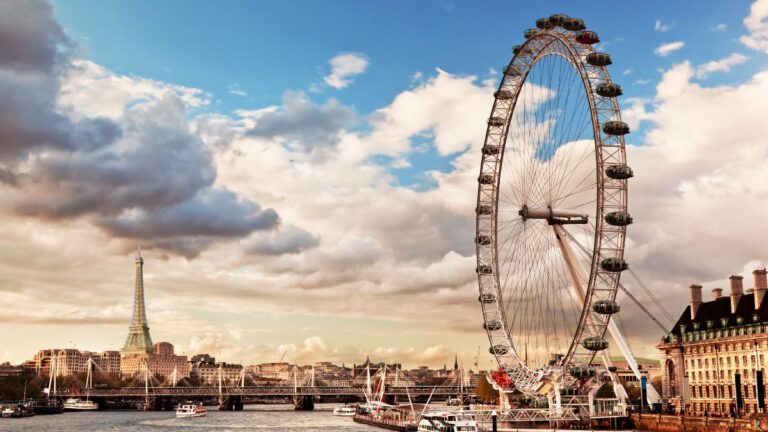Rome (Italy) Vs. London (England) Vs. Paris (France): Which City Should You Choose For Your Next Travel?

As participants in Amazon Associates and other programs, we earn from qualifying purchases. This comes at no additional cost to you. For more details, see our Affiliate Disclosure.
When planning a trip to Europe, narrowing the options can be overwhelming. Three popular destinations are Rome, London, and Paris, each with its unique history, culture, and attractions. With so much to see and do, deciding which city is the best fit for your next adventure can be challenging.
Rome, the Eternal City, is known for its ancient ruins, stunning architecture, and delicious cuisine. London, the capital of England, is a bustling metropolis with a rich history, diverse culture, and famous landmarks like Buckingham Palace and Big Ben. Paris, the City of Lights, is celebrated for its romantic ambiance, art museums, and world-renowned cuisine. Each city has its charm and allure, making choosing which one to visit next difficult. In this article, we’ll compare Rome, London, and Paris to help you decide which city is the perfect fit for your next travel experience.
History and Culture: A Look into the Past
The history and culture of Rome, London, and Paris are some of the most fascinating and influential in the world. From ancient empires to modern-day traditions, these cities offer a glimpse into the past while embracing the present. In this section, we will take a closer look at the history and culture of each city, highlighting the key events and movements that have shaped them into the iconic destinations they are today.
Rome
The Rise and Fall of the Roman Empire
The Roman Empire was one of the most powerful empires in history, spanning three continents and lasting over 500 years. Founded in 27 BC, the Roman Empire grew to encompass much of Europe, the Middle East, and North Africa, with its capital city of Rome at the center of it all. The empire’s legacy can still be felt today through architecture, language, and culture. Visitors to Rome can explore the ruins of ancient structures like the Colosseum, the Pantheon, and the Forum, all of which offer a glimpse into the empire’s grandeur and influence.
Despite its power and influence, the Roman Empire fell in the 5th century AD. Scholars point to various factors that led to its decline, including economic instability, political corruption, and overexpansion. Nevertheless, the empire’s legacy has endured through the ages, influencing countless aspects of modern society. From law and politics to art and literature, the Roman Empire’s impact on the world is undeniable, making a visit to Rome a must for anyone interested in history and culture.
The Vatican City: Center of the Roman Catholic Church
The Vatican City is a city-state within Rome and is the center of the Roman Catholic Church. Home to the Pope and the seat of the Catholic Church, the Vatican is one of the world’s most important religious and cultural destinations. The city-state is a UNESCO World Heritage site home to numerous treasures, including St. Peter’s Basilica, the Sistine Chapel, and the Vatican Museums.
Visitors to the Vatican can explore the extensive art collections, including works by famous artists such as Michelangelo, Raphael, and Caravaggio. The highlight for many visitors is the Sistine Chapel, with its iconic ceiling painted by Michelangelo, depicting scenes from the Bible. The Vatican also offers an opportunity to learn about the history of the Catholic Church, including its role in shaping Western civilization. With its rich history and religious significance, the Vatican City is a must-visit destination for anyone interested in history, culture, or religion.
The Artistic Legacy of Rome: From Michelangelo to Bernini
Rome has been a center of artistic expression for centuries, with some of the most famous artists in history leaving their mark on the city. Michelangelo, Bernini, and Caravaggio are just a few artists who called Rome home and left behind a legacy that can still be seen today. Visitors to Rome can see some of the world’s most famous works of art, including Michelangelo’s frescoes in the Sistine Chapel, his sculpture of David, and Bernini’s Baroque masterpiece, the Fountain of the Four Rivers in Piazza Navona.
Rome is also home to numerous art museums and galleries, such as the Galleria Borghese, which houses work by Bernini, Caravaggio, and Raphael. The city’s art scene continues to thrive today, with numerous contemporary art exhibitions and installations. For art lovers, Rome is an unparalleled destination, offering a chance to immerse oneself in some of the world’s most famous artistic masterpieces.
London
From Shakespeare to the Beatles: A Cultural History of London
London has been a hub of cultural innovation for centuries, with its history and artistic legacy influencing countless aspects of modern society. From the works of Shakespeare to the Beatles’ music, London has played a vital role in shaping the cultural landscape of the Western world. Visitors to the city can explore the numerous cultural landmarks, from Shakespeare’s Globe Theatre to Abbey Road Studios, where the Beatles recorded some of their most famous songs.
In addition to its cultural landmarks, London has numerous museums and galleries, including the British Museum, the National Gallery, and the Tate Modern. These institutions showcase some of the world’s most famous art and artifacts, offering a chance to immerse oneself in history and culture. Whether exploring the city’s literary and musical history or delving into its art scene, London has something to offer to everyone interested in culture and history.
The Monarchy and British Traditions: A Closer Look
The British monarchy has been integral to the country’s history and culture for centuries. The current monarch, Queen Elizabeth II, is the head of state and has reigned since 1952. The monarchy plays an important role in British society, with traditions such as changing the guard at Buckingham Palace, the annual Trooping the Colour ceremony, and the Royal Ascot horse race capturing visitors’ attention from around the world.
British traditions extend beyond the monarchy, with events like the Wimbledon tennis tournament, the Notting Hill Carnival, and the annual Guy Fawkes Night celebrations showcasing the country’s rich cultural heritage. Visitors to London can also explore historical landmarks such as the Tower of London, Westminster Abbey, and St. Paul’s Cathedral, all of which offer a glimpse into the city’s past and cultural traditions. Understanding the monarchy and British traditions is an important aspect of any visit to London, offering a chance to immerse oneself in the country’s rich history and culture.
The Industrial Revolution and Its Impact on Modern-Day London
The Industrial Revolution was a period of significant change in England, marked by the growth of factories, new technologies, and urbanization. London played a pivotal role in the Industrial Revolution, with its thriving ports and access to raw materials making it an ideal location for manufacturing. The growth of industry led to a significant increase in the population of London, with the city expanding rapidly and new suburbs and neighborhoods being developed.
Today, the impact of the Industrial Revolution can still be seen throughout London, with iconic landmarks such as the Tower Bridge and the London Eye serving as a testament to the city’s industrial past. The city’s docks and canals have also been transformed, with many being repurposed as tourist attractions, such as the Camden Market and the Regent’s Canal. The industry’s growth also led to the development of new transportation networks, such as the London Underground, which continues to serve as a vital part of the city’s infrastructure.
While the Industrial Revolution significantly impacted the city of London, it also had broader implications for the world. The growth of industry and manufacturing led to significant advancements in technology and science, helping to shape the modern world as we know it today. Understanding the impact of the Industrial Revolution is essential for anyone interested in the history and culture of London, and its enduring legacy is still visible in the city’s architecture, infrastructure, and culture.
Paris
The French Revolution: A Turning Point in History
The French Revolution was a radical social and political change in France from 1789 to 1799. It was a period marked by the overthrow of the monarchy, the rise of the Jacobins, and the Reign of Terror, which saw the execution of thousands of people. The revolution profoundly impacted the world, ushering in a new era of democracy, nationalism, and human rights.
The French Revolution also significantly impacted France’s culture, with the rise of Romanticism and the emergence of the idea of the “citizen” shaping French society. The revolution inspired a new sense of nationalism and pride in French culture, leading to the development of new art forms and cultural expressions. Visitors to Paris can explore the city’s many landmarks and museums, such as the Palace of Versailles, the Musée d’Orsay, and the Louvre, which showcase the cultural legacy of the French Revolution.
Today, the French Revolution is recognized as a turning point in history, with its impact felt in countries worldwide. The principles of liberty, equality, and fraternity, which were championed during the revolution, continue to shape modern society, and visiting Paris is an essential experience for anyone interested in the history and culture of France.
The Artistic Movement of the 19th Century: From Impressionism to Art Nouveau
The 19th century was a period of artistic innovation and experimentation, with new movements emerging throughout Europe. Two of the most significant movements of the period were Impressionism and Art Nouveau, both of which had a profound impact on the art world and continue to be celebrated today.
Impressionism, which originated in France in the 1860s, was characterized by its focus on light and color and its rejection of traditional academic techniques. Artists such as Claude Monet and Edgar Degas were among the most famous impressionists, with their works featuring bold brushstrokes and bright, vivid colors.
Art Nouveau, which emerged in the late 19th century, was characterized by its focus on natural forms and its rejection of traditional styles. The movement was marked by its intricate designs and flowing, organic shapes, with artists such as Gustav Klimt and Alphonse Mucha creating some of the period’s most famous works.
Visitors to Paris can explore the city’s many museums and galleries, which showcase the artistic legacy of the 19th century. The Musée d’Orsay is home to many impressionist masterpieces, while the Musée National Gustave Moreau is a tribute to the Art Nouveau movement. Understanding the artistic movements of the 19th century is an essential aspect of any visit to Paris, offering a chance to explore some of the most significant cultural developments of the period.
French Cuisine: The Art of Eating and Drinking in Paris
French cuisine is renowned worldwide for its sophistication, flavor, and attention to detail. Paris, in particular, is a food lover’s paradise, with a vibrant culinary scene that celebrates the best of French cuisine.
From traditional brasseries to Michelin-starred restaurants, Paris offers a range of dining options to suit every taste and budget. Some of the city’s most famous dishes include escargots, foie gras, coq au vin, and ratatouille, while its patisseries and boulangeries are famous for their croissants, baguettes, and macarons.
Paris is also known for its wine, with the city being home to some of the world’s most famous wine regions. Visitors can sample the best French wine at one of the city’s many wine bars or tour nearby vineyards.
In addition to its traditional cuisine, Paris is known for its innovative culinary scene, with new restaurants and food concepts always emerging. The city’s vibrant street food scene is also worth exploring, with food trucks and markets offering a range of delicious and affordable options.
For anyone interested in food and drink, Paris is an essential destination, offering a chance to explore the art of French cuisine and experience some of the best food and wine in the world.
Attractions and Landmarks: Must-See Sites in Each City
Rome
The Colosseum: The Iconic Symbol of Ancient Rome
The Colosseum is one of the world’s most iconic and recognizable landmarks. This ancient theater was built nearly 2,000 years ago and was the site of some of Rome’s most famous and brutal spectacles. The Colosseum could hold up to 80,000 spectators and was used for gladiatorial contests, animal hunts, and mock sea battles.
Today, the Colosseum is a major tourist attraction that millions visit yearly. Visitors can explore the interior of the Colosseum and learn about its history through exhibits and audio guides. The surrounding area is also worth exploring, with the nearby Roman Forum offering a glimpse into the daily life of ancient Romans.
Understanding the significance of the Colosseum is an essential part of any visit to Rome, offering a chance to explore one of the most famous landmarks in the world and learn about the rich history and culture of ancient Rome.
The Pantheon: A Masterpiece of Ancient Architecture
The Pantheon is one of Rome’s most impressive ancient buildings and is considered a masterpiece of ancient architecture. Built-in 27 BC, the Pantheon was originally a temple dedicated to all the gods of ancient Rome. Its iconic dome, which spans nearly 43 meters in diameter, was the largest unsupported dome in the world until the 20th century.
The interior of the Pantheon is equally impressive, with a soaring dome and a series of niches housing statues of various gods and goddesses. The building’s original bronze roof tiles were also melted down to create the canopy of the altar in St. Peter’s Basilica.
Today, the Pantheon is a major tourist attraction and a symbol of Rome’s rich cultural heritage. Visitors can explore the building’s interior and marvel at its intricate design and engineering feats. The surrounding Piazza della Rotonda is also popular for people-watching and soaking up the atmosphere of this historical part of Rome.
For anyone interested in ancient architecture and history, the Pantheon is a must-visit destination in Rome, offering a chance to explore one of the most impressive and iconic buildings of the ancient world.
The Vatican City: Home to St. Peter’s Basilica and the Sistine Chapel
Vatican City is a city-state in Rome and the world’s smallest country. It is home to the Catholic Church and is considered the spiritual center of the Christian world. The Vatican City is also home to some of the most iconic landmarks in Rome, including St. Peter’s Basilica and the Sistine Chapel.
St. Peter’s Basilica is one of the world’s largest and most impressive churches and is considered a masterpiece of Renaissance architecture. The basilica’s dome, designed by Michelangelo, is an iconic city symbol and can be seen from miles away.
The Sistine Chapel, located within the Vatican Museums, is also a must-see destination in Vatican City. The chapel is famous for its ceiling, painted by Michelangelo, and depicts scenes from the Bible. The Last Judgment, also painted by Michelangelo, covers the entire altar wall of the chapel.
Visitors to Vatican City can explore the numerous museums, galleries, and other landmarks, including the Vatican Gardens and the Apostolic Palace. The city-state hosts regular events and ceremonies, including the Papal audience and the annual Christmas Eve Mass.
Understanding the cultural and religious significance of the Vatican City is an essential part of any visit to Rome, offering a chance to explore some of the most famous and iconic landmarks in the world and learn about the history and culture of the Catholic Church.
London
The Tower of London: A Fortress with a Dark Past
The Tower of London is a historic fortress located on the banks of the River Thames in London. The tower was built in the 11th century by William the Conqueror and has played an important role in the city’s history. Over the years, it has been used as a royal palace, a prison, and a place of execution, earning a reputation for being one of the most haunted buildings in the world.
The Tower of London has a dark and bloody past, with numerous executions. Some of the most famous prisoners held at the tower include Anne Boleyn, the second wife of King Henry VIII, and Guy Fawkes, who was involved in the failed Gunpowder Plot of 1605.
Today, the Tower of London is a major tourist attraction. Visitors can explore the building’s many exhibits and collections, including the Crown Jewels, the White Tower, and the Royal Armouries. The tower’s iconic Beefeaters, who serve as ceremonial guards and tour guides, are also a popular attraction.
Visiting the Tower of London offers a chance to explore one of the most famous landmarks in London and learn about its rich history, from its role as a royal palace to its time as a place of imprisonment and execution.
Buckingham Palace: The Official Residence of the British Monarchy
Buckingham Palace is the official residence of the British monarchy and is located in the heart of London. The palace has served as the residence of the British monarch since the 19th century, and it is the site of many important events, such as state visits, royal weddings, and other ceremonial occasions.
The palace has 775 rooms, including 19 staterooms, 52 royal and guest bedrooms, 188 staff, and 92 offices. Visitors can explore the State Rooms during the summer months, which feature some of the most impressive artwork, furniture, and decorations from the Royal Collection.
One of the most famous features of Buckingham Palace is the Changing of the Guard ceremony, which takes place daily during the summer months and on alternate days during the rest of the year. The ceremony is a colorful and traditional display of British pomp and ceremony, as the Old Guard hands over responsibility for the security of the palace to the New Guard.
For anyone interested in the British monarchy and the history of London, a visit to Buckingham Palace is an essential experience. It offers a chance to explore one of the most famous landmarks in London and learn about the history and traditions of the British monarchy.
The British Museum: Home to Countless Artifacts and Treasures
The British Museum is one of the world’s largest and most comprehensive museums, featuring an extensive collection of artifacts and treasures from across the globe. The museum’s collections span over two million years of human history. They include everything from ancient Egyptian mummies to Greek and Roman antiquities and from Asian art to medieval European treasures.
The museum’s most famous exhibits include the Rosetta Stone, which helped to decipher hieroglyphics. The Elgin Marbles, a collection of sculptures from the Parthenon in Athens, and the Sutton Hoo treasure, a collection of Anglo-Saxon artifacts. Other notable exhibits include ancient Assyrian reliefs and Egyptian mummies.
The British Museum is also home to a range of temporary exhibits and events which showcase contemporary art, cultural events, and other special exhibitions. Visitors can also explore the museum’s libraries and archives, which contain some of the world’s most significant manuscripts and books.
For anyone interested in history, art, and culture, visiting the British Museum is an essential experience. It offers a chance to explore some of the most significant artifacts and treasures from around the world and learn about humanity’s rich cultural heritage.
Paris
The Eiffel Tower: The Iconic Symbol of Paris
The Eiffel Tower is one of the world’s most iconic and recognizable landmarks and is considered the symbol of Paris. The tower was built in 1889 by Gustave Eiffel. It was originally intended as a temporary installation for the 1889 World’s Fair, but its popularity led to its preservation as a permanent fixture on the Parisian skyline.
The tower is 324 meters tall and offers stunning city views from observation decks. Visitors can take the elevator or climb the stairs to the first and second levels, enjoying panoramic views of Paris. The third level is reserved for private events and is not open to the public.
The Eiffel Tower is also home to several restaurants and cafes, including the Michelin-starred Le Jules Verne, which offers panoramic views of the city while dining on fine French cuisine.
The tower is a major tourist attraction and is visited by millions yearly. Its iconic design and engineering feats make it one of the most famous landmarks in the world, and it serves as a symbol of Paris’s rich cultural heritage.
For anyone visiting Paris, a trip to the Eiffel Tower is an essential experience, offering a chance to explore one of the world’s most famous and iconic landmarks and enjoy stunning views of the city.
The Louvre Museum: Home to Some of the World’s Most Famous Artworks
The Louvre Museum is one of the world’s most famous and prestigious art museums, housing an extensive collection of art and artifacts from around the world. Located in the heart of Paris, the Louvre houses some of the world’s most famous artworks, including the Mona Lisa, the Winged Victory of Samothrace, and the Venus de Milo.
The museum’s collection spans over 9,000 years of history and includes works of art from ancient civilizations, such as Egypt, Greece, and Rome, as well as medieval, Renaissance, and modern art. The Louvre also houses an extensive collection of Islamic art, decorative art, prints, and drawings.
Visitors to the Louvre can explore the museum’s vast collections and enjoy guided tours and audio guides. The museum also offers a range of temporary exhibitions and events, showcasing contemporary art and other special exhibitions.
The Louvre is an essential destination for anyone interested in art and culture, offering a chance to explore some of the world’s most famous artworks and learn about the history and development of art over the centuries. It is an iconic symbol of Paris and a must-visit destination for any visitor to the city.
Notre Dame Cathedral: A Masterpiece of Gothic Architecture
Notre Dame Cathedral is one of Paris’s most famous and iconic landmarks, known for its stunning Gothic architecture and rich cultural history. The cathedral was built in the 12th century and is considered a masterpiece of medieval engineering and design.
The cathedral’s Gothic architecture is characterized by its ribbed vaults, flying buttresses, and pointed arches, which created towering, light-filled spaces. The cathedral’s iconic facade features a series of intricate carvings and sculptures, including the famous gargoyles that adorn its rooftop.
The cathedral also has a rich cultural history, the site of numerous significant events throughout the centuries. It was the site of the coronation of Napoleon Bonaparte, and it played a prominent role in Victor Hugo’s famous novel, “The Hunchback of Notre Dame.”
In 2019, a devastating fire broke out at Notre Dame Cathedral, causing significant damage to its roof and spire. However, restoration efforts are underway, and the cathedral is expected to be restored to its former glory.
For anyone interested in history and architecture, Notre Dame Cathedral is an essential destination in Paris, offering a chance to explore one of the most famous and iconic buildings in the world and learn about the rich cultural heritage of France.
Each city has countless other attractions and landmarks, from parks and gardens to historic neighborhoods and cultural institutions.
Food and Drink: A Culinary Journey Through Rome, London, and Paris
Food and drink are an essential part of any travel experience, offering a chance to explore the local cuisine and learn about the cultural traditions of the places you visit. Rome, London, and Paris are all famous for their unique culinary scenes, with various traditional and contemporary dishes to explore.
In Rome, visitors can sample traditional Italian dishes, such as pizza, pasta, and gelato, as well as local specialties like carbonara, cacio e pepe, and amatriciana. The city is also famous for its wine, with local varieties like Chianti and Brunello di Montalcino being popular.
In London, visitors can explore the city’s vibrant culinary scene, which includes traditional British dishes like fish and chips, bangers and mash, and roast beef with Yorkshire pudding. The city is also famous for its multicultural cuisine, with Indian, Chinese, and other international foods available throughout the city.
Paris is known for its sophisticated and elegant culinary scene, with traditional French dishes like coq au vin, beef bourguignon, and escargots being popular choices. The city is also famous for its patisseries and bakeries, which offer a range of sweet treats like macarons, croissants, and pain au chocolat.
In addition to their traditional cuisine, Rome, London, and Paris are home to innovative and contemporary culinary scenes, with new restaurants and food concepts always emerging. Visitors can explore local markets, food festivals, and other culinary events to sample each city’s food and drink.
Exploring the culinary traditions of Rome, London, and Paris is an essential part of any trip to these iconic cities, offering a chance to experience each destination’s rich cultural heritage and diverse culinary scenes.
Accommodations: Where to Stay for the Ultimate Experience
Accommodations are an essential part of any travel experience, and each city offers a range of options for visitors. Whether you’re looking for a luxury hotel, a budget-friendly hostel, or a unique boutique property, Rome, London, and Paris, all have something to offer.
In Rome, visitors can choose from various hotels and guesthouses, many of which are historic buildings and offer stunning views of the city’s landmarks. Hostels and guesthouses are also available for those looking for a more budget-friendly option, offering a chance to experience the city’s culture and atmosphere at a more affordable price.
In London, visitors can choose from luxury hotels, including the world’s most iconic properties, such as The Savoy and The Ritz. Budget-friendly options, such as hostels and budget hotels, are also available throughout the city, as are unique boutique properties and apartments.
In Paris, visitors can choose from a range of luxurious hotels, many of which are located in historic buildings and offer stunning views of the city’s landmarks. Budget-friendly options, such as hostels and budget hotels, are also available throughout the city, as are unique boutique properties and apartments.
For those looking for a unique and unforgettable experience, there are also a range of alternative accommodations available in each city, including houseboats, treehouses, and glamping sites.
When choosing accommodations, it’s important to consider factors such as location, amenities, budget, and overall experience you’re looking for. By selecting the right accommodations, you can ensure that your trip to Rome, London, or Paris is everything you want.
Transportation: Getting Around in Rome, London, and Paris
Getting around Rome, London, and Paris can be an adventure, with each city offering visitors a range of transportation options.
In Rome, the most popular mode of transportation is the metro, which offers quick and convenient access to the city’s main attractions. Visitors can also use buses and trams to get around the city, as well as taxis and ride-sharing services. However, for those who prefer to explore the city on foot, Rome’s compact size and pedestrian-friendly streets make it easy to navigate.
In London, visitors can use the iconic red buses and black cabs to get around the city and the extensive network of underground trains and overground trains. The city also offers bike rentals and ride-sharing services for those who prefer to explore the city on two wheels. For those who prefer to walk, London’s numerous parks and green spaces offer a chance to explore the city on foot.
In Paris, visitors can use the extensive network of metro trains and buses to get around the city, as well as the iconic Vélib’ bike-sharing system. Taxis and ride-sharing services, and boat tours along the Seine River are also available. Paris is also a city that is easily explored on foot, with many of its main attractions within walking distance of each other.
When traveling in Rome, London, and Paris, planning your transportation ahead of time is important, considering factors such as traffic, distance, and cost. By selecting the right transportation options, you can ensure that your travels in these iconic cities are smooth and hassle-free.
Budget: Comparing Costs for Your Trip
When planning a trip to Rome, London, or Paris, it’s important to consider your budget and compare travel costs, accommodations, food, and activities in each city.
Rome is generally considered a more budget-friendly destination, with affordable accommodations, budget-friendly dining options, and low-cost activities. However, the city can be more expensive during peak tourist season, and attractions such as the Colosseum and the Vatican Museums can have high admission fees.
London is known for being one of the more expensive cities in Europe, with high costs for accommodations, food, and activities. However, budget-friendly options remain, such as budget hotels, hostels, and free activities such as visiting museums and exploring the city’s many parks.
Paris is also considered a relatively expensive destination, with high accommodations, dining, and activities costs. However, budget-friendly options remain, such as budget hotels and hostels, free activities such as exploring the city’s many parks and gardens, and affordable dining options such as street food and local cafes.
When planning a trip to any of these cities, it’s important to research and compares costs ahead of time, considering factors such as exchange rates, seasonality, and local taxes. Planning and budgeting carefully allow you to enjoy all that Rome, London, and Paris offer without breaking the bank.
Weather and Seasons: When to Visit Each City
The best time to visit Rome, London, and Paris depends on personal preferences, budget, and the desired travel experience. Each city has its unique climate, seasons, and weather patterns, which can affect the overall travel experience.
Rome experiences a Mediterranean climate with hot, dry summers and mild, wet winters. The peak tourist season in Rome is from June to August when the weather is warm and sunny, but crowds and prices can be high. The best time to visit Rome is in the spring (April to June) or fall (September to November), when the weather is mild and pleasant, and there are fewer crowds.
London has a temperate climate with mild temperatures year-round, and rainfall is common throughout the year. The peak tourist season in London is from June to August when the weather is warm and sunny, but crowds and prices can be high. The best time to visit London is in the spring (March to May) or fall (September to November), when the weather is mild and there are fewer crowds.
Paris has a mild, temperate climate with cool temperatures and yearly rainfall. The peak tourist season in Paris is from June to August when the weather is warm and sunny, but crowds and prices can be high. The best time to visit Paris is in the spring (April to June) or fall (September to November), when the weather is mild and there are fewer crowds.
The best time to visit Rome, London, and Paris is during the spring or fall when the weather is mild and there are fewer crowds. However, travelers who prefer warm, sunny weather and don’t mind larger crowds may prefer to visit during summer. The winter can also offer a unique travel experience with fewer crowds and holiday festivities but cooler temperatures and shorter daylight hours.
Language and Communication: Tips for Travelers
When traveling to Rome, London, or Paris, knowing the local language and communication customs is important. Although English is widely spoken in all three cities, learning a few basic phrases in the local language is always helpful.
Italian is the official language in Rome, and many locals speak English, particularly in tourist areas. However, learning a few basic phrases in Italian can go a long way in connecting with locals and enhancing the travel experience.
English is the official language in London, and communication should not be a problem for most travelers. However, it’s important to be aware of local customs and accents, which can vary depending on the area.
In Paris, French is the official language, and while many locals speak English, it’s always helpful to learn a few basic phrases in French, such as “bonjour” (hello), “merci” (thank you), and “au revoir” (goodbye). Being polite and respectful in your interactions with locals can go a long way in making connections and improving your travel experience.
When communicating with locals, it’s important to be patient and understanding, particularly if language barriers exist. Using nonverbal cues, such as gestures and facial expressions, can help to overcome these barriers and make communication easier.
In addition, it’s important to be aware of local customs and etiquette, such as how to greet people, what is appropriate to dress, and how to behave in public spaces. By being respectful and mindful of local customs, travelers can make the most of their experience in Rome, London, or Paris.
Safety and Security: Important Considerations for Your Trip
When traveling to Rome, London, or Paris, safety and security should be a top priority. While these cities are generally safe for travelers, taking precautions and being aware of potential risks is important.
In Rome, travelers should be cautious of pickpocketing and other petty crimes, particularly in crowded areas such as tourist attractions and public transportation. It’s also important to be aware of traffic and road safety when crossing streets, as drivers can be aggressive.
In London, travelers should be aware of the potential for terrorist attacks, particularly in crowded areas such as tourist attractions and public transportation. It’s also important to be aware of traffic and road safety when crossing streets, as drivers can be aggressive.
In Paris, travelers should be cautious of pickpocketing and other petty crimes, particularly in crowded areas such as tourist attractions and public transportation. It’s also important to know the potential for terrorist attacks, particularly in crowded areas.
To stay safe while traveling in these cities, taking precautions such as keeping valuables secure, being aware of your surroundings, and avoiding unsafe areas is important. It’s also helpful to familiarize yourself with local emergency services and have a plan in case of an emergency.
When using public transportation, it’s important to be aware of potential risks, such as pickpocketing and theft. It’s also important to be aware of the potential for terrorist attacks and to report any suspicious behavior to authorities.
Overall, by taking precautions and being aware of potential risks, travelers can enjoy a safe and memorable trip to Rome, London, or Paris.
Local Customs and Etiquette: How to Respectfully Navigate Each City
When traveling to Rome, London, or Paris, it’s important to be mindful of local customs and etiquette to ensure a respectful and enjoyable experience for travelers and locals.
In Rome, it’s important to dress modestly when visiting churches and religious sites, covering your shoulders and knees. It’s also important to respect local traditions and customs, such as dining and social customs.
In London, it’s important to be punctual for appointments and meetings, as delay is generally considered impolite. Tipping is also customary in London, particularly in restaurants and for taxi rides.
In Paris, greeting people politely and using “Bonjour” or “Bonsoir” when entering a shop or restaurant is important. It’s also important to be patient and polite in interactions with locals, particularly in busy areas such as tourist attractions and public transportation.
When dining in these cities, it’s important to know local customs and etiquette, such as tipping practices and dining traditions. In Rome, for example, it’s customary to order an espresso after a meal, while in Paris, it’s common to enjoy a leisurely meal with several courses.
When visiting religious sites and monuments, it’s important to be respectful and follow any rules or regulations regarding dress and behavior. In addition, it’s important to respect local traditions and customs, such as observing quiet hours and being mindful of local cultural practices.
Travelers can ensure a positive and enjoyable experience in Rome, London, and Paris by being respectful and mindful of local customs and etiquette.






